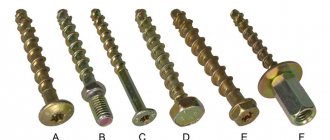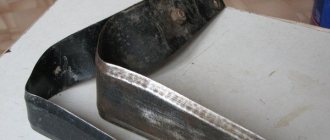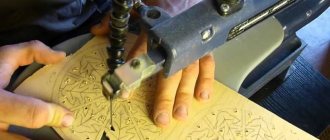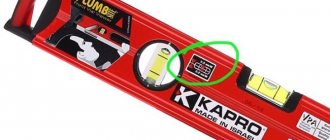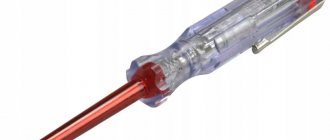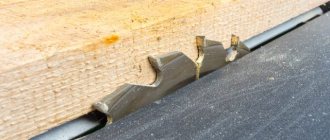Many beginners are interested in the question of how to work with an electric planer. At first glance, there is nothing complicated: plug it into a power outlet, press a button, move it back and forth across the surface, removing chips. However, during the first attempts, the result is not always impressive.
Electric planer device.
When purchasing a tool, you need to check its functionality, completeness and appearance. It is worth paying attention to the sharpening quality of the installed knives. If the kit contains spare knives, you need to check them too. The cutting edge should be smooth, sharp, without gouges or bends. All other settings should be checked at home in accordance with the manufacturer's instructions.
Checking and adjusting the position of the front plate
All adjustments to the tool must be made in the off state. The plug must be unplugged from the socket, otherwise you can not only damage the electric planer, but also cause serious injury.
Table of main parameters of electric planers.
When checking the position of the knives, the front plate must be set to the minimum planing depth position using the standard adjustment knob. Place the electric planer on a flat, hard surface with the drum facing up.
To check, you can use a metal ruler or a piece of window glass of suitable dimensions. The drum with knives should be rotated until one of the knives is in the upper position, above the drum axis. The ruler or glass must be laid on the slabs along the plane. The surfaces must be in the same plane.
If the control device on any of the plates is tilted, you need to check the position of the front plate and adjust it. Such a defect occurs during long-term operation of the tool without maintenance. The internal cavities can become clogged with wood dust and small shavings. Excessive force on the depth adjustment handle displaces it from its original position.
To eliminate the defect, you need to remove the handle, the front plate, clean the cavities from dust and chips, and lubricate them. Place the plate in place, check the installation using a ruler, secure the handle, checking that the dial matches the index mark.
Finishing the knife on the belt
Like a straight razor, a plane knife, after sharpening on a block and a whetstone, can be further sharpened using a leather belt. To do this, apply polishing paste to the knife and run it back and forth along the belt a couple of times. This removes any remaining burr.
A little training
Since the need for a plane does not arise as often as before, many home craftsmen lack the skills to use it. It is unlikely that you will be able to carefully process the surface of the part with a plane the first time. Therefore, it is worth practicing on substandard boards first to gain the necessary confidence. Only after gaining some experience can you use a plane for finishing parts and finished products.
Adjusting the position of the cutting edge
Adjustment of the position of the knives is carried out according to two parameters:
- height of the cutting edge relative to the back plate;
- the size of the protruding part of the knife for planing quarters.
Layout of the drum with blades.
Having installed the ruler or glass, you need to rotate the drum, controlling the gap between the knife and the device at the edges of the slabs. The edge of the knife should lightly touch the tool without lifting it. If the knife clings to the device or does not reach it, the position must be adjusted.
Typically, knives are secured with a special wedge with expansion bolts. Using an 8 or 10 wrench, you need to screw the bolts into a wedge until the bolt moves freely. Then, using the installed eccentrics, align the height of the cutting edge with the device. Tighten (unscrew) the mounting bolts and check the position again. The desired result can be achieved after several repetitions of this operation.
At the same time as adjusting the height of the cutting edge, you need to control the protruding part of the quarter planing knife. The optimal size should be indicated in the manufacturer's instructions. On most models it is 1 mm. The size is set by moving the knife left or right along the axis of the drum. It is important to set the size correctly. It should be the same on all knives. This can be achieved by using a feeler gauge of a certain size or by measuring the distance with a caliper (a caliper with a protruding back) from the edge of the knife to the drum. After adjusting the first knife, you need to move on to the next ones. The operation for all knives is performed similarly. If a knife cannot be installed in the required position, you need to remove the wedge and check the eccentrics for integrity and free rotation.
The adjustment must be completed by checking the free rotation of the drum and the fastening of all knives.
Summarize
As you can see, you can’t do carpentry with just a plane. When processing workpieces, you have to perform a number of operations. Some tools work in pairs, for example, tongue and groove, others are used sequentially: for roughing - sherhebel, for finishing - jointer.
Now you know what woodworking operations each type of plane is intended for. Learn carpentry and improve your skills with the right tools. Order it in our online store!
Preparing for work
The tool can be used in two positions:
Plane sharpening angle diagram.
- stationary position: the electric planer is attached to a rigid, stable surface;
- portable: the tool is moved manually along the workpiece.
Many models come with special clamps and a bracket for the start button. In a stationary position, it is more convenient to process short-length lumber, which can be moved along the tool alone. It is advisable to process long workpieces with a portable electric planer.
The wood must be dried; raw lumber is poorly processed. The board must be firmly secured to a hard surface. The part should not sag under the weight of the plane and shift during operation in any direction. When processing side surfaces on a workbench, it is advisable to install them on special fastenings that protect them from bending and movement. In the area of rotation of the drum with knives there should be no metal elements (brackets, nails, screws) on the surface being processed or fastening elements. Hitting the metal will leave a gouge in the blades, and a protrusion will form on the surface being treated. The knives will have to be sharpened, removing a thick layer of metal, or replaced.
Safety regulations
Be careful when working. Follow a few simple rules.
- Pay close attention to the quality of the workpiece. Working on wet wood is not recommended.
- Do not push out chips with your hands . This can cause you to cut yourself or get a splinter.
- Before planing, you need to set up the tool on a workbench ; you need to place it on its side with the blade in the opposite direction from the worker.
- You need to pass the tool to another person with the blade facing you.
- Dropping the tool is not recommended.
To learn how to put a hand plane into working condition, see the following video.
Surface treatment
An electric planer can perform three operations:
Scheme of options for sharpening a plane knife.
- chamfer at different angles;
- select quarters on blanks;
- plan surfaces.
The main purpose of the tool is to plan surfaces of various lengths and widths.
When working, the plane must be placed on the surface of the workpiece with the front plate so that the knives do not touch the surface. Press the start button, after picking up speed (the sound stops changing pitch) begin moving the plane along the surface. The tool must be held strictly parallel to the surface being processed, the movement must be uniform, without jerking or stopping. When starting to move, you need to increase the pressure on the front part, and when exiting the surface to the rear part. The plane should work smoothly, without vibration. If strong vibration occurs or the sound changes during operation, you need to turn off the tool, determine and eliminate the cause of the abnormal operation.
The depth of the passage must be set depending on the processing purposes. If you need to change the size of the workpiece, you can use the maximum size. When leveling the surface, it is advisable to work with a shallow processing depth, achieving the required quality in several passes.
Also, the depth of processing depends on the material. Hard rocks should be passed several times at shallow depths to avoid overloading the tool.
What is done with a plane and its varieties
Each type of plane is designed for a specific task or nuance.
- Planer: needed to level the surface over a large area.
It is distinguished by a long sole and the presence of a double incisor. The first chip is obtained from separate pieces, the second is continuous, finishing. The good thing about the jointer is that it is suitable for almost untreated surfaces.
Jointer
- End plane: used to obtain a finishing surface of the ends.
The main difference is the short length and installation angle of the knife (21 degrees).
End plane
- Additional planer: purpose - high-quality cutting of corners along the edges of the workpiece. For this purpose, an adjustable mechanism is made. The cutting edge is made of high-hardness steel.
- Tongue (groove): used for selecting tongues - narrow grooves at a certain distance from the end.
It has a guide to strictly maintain the parallelism of the resulting groove and the side edge. The depth and width of the groove are adjustable.
Tongue and pile pile
- Zenzubel: for creating features such as long grooves and edges on wood surfaces.
Performs cutting of grooves and grooves, processing edges, quarters and folds. The selector (another name) deepens the intended groove.
Zenzubel
- Rebate: the tool is designed for making grooves for installing glass.
It differs from the usual zenzubel, which is also needed for grooves, in its sole with steps. Parts of the sole can be removable. You can install another special knife on the side - for the quarter wall.
- Sander and double sander: allow you to get a super clean surface. The knife is installed at an angle of 50 degrees (the usual value is 45 degrees).
- Kalevka: figured processing of the edges of the workpiece.
- Tsinubel: a device needed for making small depressions for further gluing of parts (technological increase in usable area).
- Primer: gives the workpiece the specified function of a trapezoidal groove - using a specially shaped knife. The groove is located across the fibers of the material.
There are other, much more specialized, varieties of planes used at the professional level. Including the creation of rounded shapes (for example, a staff gobel).
Additional tool features
To remove chamfers, you need to use a special triangular groove cut out on the front plate of the plane.
The tool should be positioned with the groove at the angle to be processed, launched and moved along the part while maintaining the tilt. The first pass is made along the slot; subsequent passes, if necessary, are carried out in the usual manner.
To make quarters on a plane, you need to install an additional stop to limit movement away from the direction of movement. The second stop, limiting the depth of the quarter, is located on the side surface. The stops must be set to the required dimensions. The distance should be measured from the angle of the cutting edge of the knife in the upper position. The quarter selection is performed in several passes. If the vertical surface of the quarter turns out to be steps, it is necessary to increase the protrusion of the knives beyond the side surface of the plane.
A wide surface of lumber can be processed in several passes. Processing should begin from the left edge, setting the adjustment to the minimum depth. The next pass should be performed offset to the right by about a third of the length of the knives. In this way you need to go across the entire width of the workpiece. If the quality is unsatisfactory, repeat the surface treatment in a similar way.
Planing with an electric planer
A separate condition for correct and safe planing of any structures with electric planers is the rigid fixation of the workpiece being processed.
Only after the workpiece being processed is clearly fixed, you can start planing it. First you should start with rough processing. For this, sherhebel is often used. When using scherhebel, movements should be directed not along, but across the fibers. Otherwise, you may cut off too much wood.
Subtleties of working with an electric planer
After finishing processing the surface of small workpieces with Sherhebel, it should be cleaned first with a single, then with a double plane. If you are dealing with long workpieces, such as bars, then it is better to use a jointer or semi-jointer. Movement on the surface must be directed not against the grain, but along it. This is the only way you can get the most even and smooth surface of the wood.
Planing
